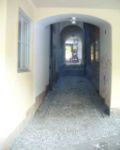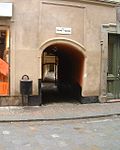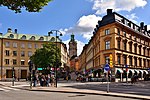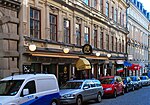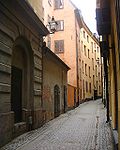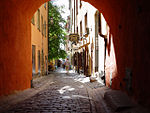Kolmätargränd

Kolmätargränd is a small alley in Gamla stan, the old town in central Stockholm, Sweden. Passing under a low vault it connects the street Västerlånggatan to the square and courtyard Brantingtorget forming a parallel street to Klockgjutargränd and Stenbastugränd. Mentioned as Kholmetare Grenden in 1646 and Kåålmäterenss grändh in 1652, the alley is named after the assessor and magistrate Hans Kohlmeter (1626–1686), who according to a source dated 1661 had his house built over the alley. While this name seems to have been established around 1700, the commonly used name for the alley during the 17th century was Johan Sekreterares Gränd (Johannis secretereres grend, "Alley of Secretary John"), and a century earlier Herman Ruggens gränd (1584).
Excerpt from the Wikipedia article Kolmätargränd (License: CC BY-SA 3.0, Authors, Images).Kolmätargränd
Kolmätargränd, Stockholm Gamla stan (Södermalms stadsdelsområde)
Geographical coordinates (GPS) Address Nearby Places Show on map
Geographical coordinates (GPS)
| Latitude | Longitude |
|---|---|
| N 59.326 ° | E 18.068583333333 ° |
Address
Kolmätargränd
Kolmätargränd
111 28 Stockholm, Gamla stan (Södermalms stadsdelsområde)
Sweden
Open on Google Maps
